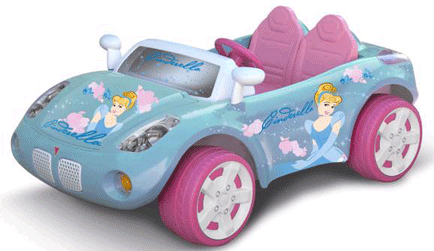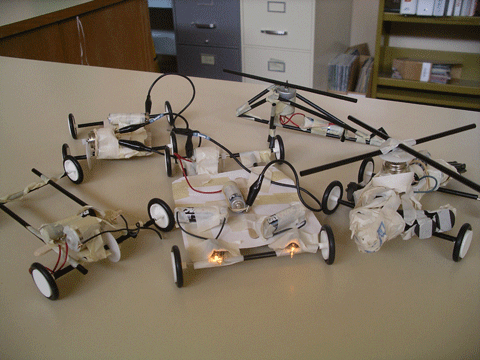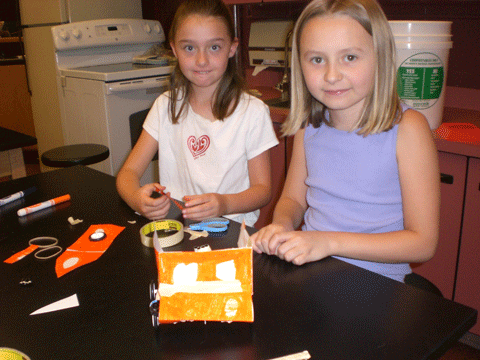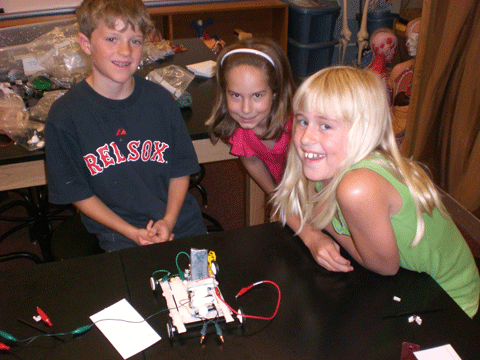Quick Look
Grade Level: 4 (3-5)
Time Required: 2 hours
(can be split into two 60-minute sessions)
Expendable Cost/Group: US $3.00
Group Size: 3
Activity Dependency:
Subject Areas: Measurement, Physical Science, Problem Solving, Science and Technology
NGSS Performance Expectations:

| 3-5-ETS1-1 |
| 3-5-ETS1-2 |
| 3-5-ETS1-3 |
Summary
Working as if they are engineers who work for (the hypothetical) Build-a-Toy Workshop company, students apply their imaginations and the engineering design process to design and build prototype toys with moving parts. They set up electric circuits using batteries, wire and motors. They create plans for project material expenses to meet a budget.
Engineering Connection
Modern toys often incorporate items such as electric motors, radio transmitters and receivers, and electronic voice systems, which are fairly technologically advanced. Toys with or without electronic components are engineered with careful attention paid to their shapes and material composition. Due to the complex nature of the toy design and manufacturing industry, toy engineering often relies upon persons with diverse engineering backgrounds that lend themselves to work in multidisciplinary teams.
Learning Objectives
After this activity, students should be able to:
- Apply the engineering design process to a design challenge.
- Create a plan for project material expenses based on a budget.
- Set up an electric circuit using batteries, wire, and a motor.
Educational Standards
Each TeachEngineering lesson or activity is correlated to one or more K-12 science,
technology, engineering or math (STEM) educational standards.
All 100,000+ K-12 STEM standards covered in TeachEngineering are collected, maintained and packaged by the Achievement Standards Network (ASN),
a project of D2L (www.achievementstandards.org).
In the ASN, standards are hierarchically structured: first by source; e.g., by state; within source by type; e.g., science or mathematics;
within type by subtype, then by grade, etc.
Each TeachEngineering lesson or activity is correlated to one or more K-12 science, technology, engineering or math (STEM) educational standards.
All 100,000+ K-12 STEM standards covered in TeachEngineering are collected, maintained and packaged by the Achievement Standards Network (ASN), a project of D2L (www.achievementstandards.org).
In the ASN, standards are hierarchically structured: first by source; e.g., by state; within source by type; e.g., science or mathematics; within type by subtype, then by grade, etc.
NGSS: Next Generation Science Standards - Science
| NGSS Performance Expectation | ||
|---|---|---|
|
3-5-ETS1-1. Define a simple design problem reflecting a need or a want that includes specified criteria for success and constraints on materials, time, or cost. (Grades 3 - 5) Do you agree with this alignment? |
||
| Click to view other curriculum aligned to this Performance Expectation | ||
| This activity focuses on the following Three Dimensional Learning aspects of NGSS: | ||
| Science & Engineering Practices | Disciplinary Core Ideas | Crosscutting Concepts |
| Define a simple design problem that can be solved through the development of an object, tool, process, or system and includes several criteria for success and constraints on materials, time, or cost. Alignment agreement: | Possible solutions to a problem are limited by available materials and resources (constraints). The success of a designed solution is determined by considering the desired features of a solution (criteria). Different proposals for solutions can be compared on the basis of how well each one meets the specified criteria for success or how well each takes the constraints into account. Alignment agreement: | People's needs and wants change over time, as do their demands for new and improved technologies. Alignment agreement: |
| NGSS Performance Expectation | ||
|---|---|---|
|
3-5-ETS1-2. Generate and compare multiple possible solutions to a problem based on how well each is likely to meet the criteria and constraints of the problem. (Grades 3 - 5) Do you agree with this alignment? |
||
| Click to view other curriculum aligned to this Performance Expectation | ||
| This activity focuses on the following Three Dimensional Learning aspects of NGSS: | ||
| Science & Engineering Practices | Disciplinary Core Ideas | Crosscutting Concepts |
| Generate and compare multiple solutions to a problem based on how well they meet the criteria and constraints of the design problem. Alignment agreement: | Research on a problem should be carried out before beginning to design a solution. Testing a solution involves investigating how well it performs under a range of likely conditions. Alignment agreement: At whatever stage, communicating with peers about proposed solutions is an important part of the design process, and shared ideas can lead to improved designs.Alignment agreement: | Engineers improve existing technologies or develop new ones to increase their benefits, to decrease known risks, and to meet societal demands. Alignment agreement: |
| NGSS Performance Expectation | ||
|---|---|---|
|
3-5-ETS1-3. Plan and carry out fair tests in which variables are controlled and failure points are considered to identify aspects of a model or prototype that can be improved. (Grades 3 - 5) Do you agree with this alignment? |
||
| Click to view other curriculum aligned to this Performance Expectation | ||
| This activity focuses on the following Three Dimensional Learning aspects of NGSS: | ||
| Science & Engineering Practices | Disciplinary Core Ideas | Crosscutting Concepts |
| Plan and conduct an investigation collaboratively to produce data to serve as the basis for evidence, using fair tests in which variables are controlled and the number of trials considered. Alignment agreement: | Tests are often designed to identify failure points or difficulties, which suggest the elements of the design that need to be improved. Alignment agreement: Different solutions need to be tested in order to determine which of them best solves the problem, given the criteria and the constraints.Alignment agreement: | |
Common Core State Standards - Math
-
Multiply and divide within 100.
(Grade
3)
More Details
Do you agree with this alignment?
-
Fluently add and subtract multi-digit whole numbers using the standard algorithm.
(Grade
4)
More Details
Do you agree with this alignment?
International Technology and Engineering Educators Association - Technology
-
Students will develop an understanding of the attributes of design.
(Grades
K -
12)
More Details
Do you agree with this alignment?
-
Students will develop an understanding of engineering design.
(Grades
K -
12)
More Details
Do you agree with this alignment?
-
Students will develop abilities to apply the design process.
(Grades
K -
12)
More Details
Do you agree with this alignment?
-
Apply the technology and engineering design process.
(Grades
3 -
5)
More Details
Do you agree with this alignment?
-
Illustrate that there are multiple approaches to design.
(Grades
3 -
5)
More Details
Do you agree with this alignment?
State Standards
Colorado - Math
-
Multiply and divide within 100.
(Grade
3)
More Details
Do you agree with this alignment?
-
Fluently add and subtract multi-digit whole numbers using standard algorithms.
(Grade
4)
More Details
Do you agree with this alignment?
Colorado - Science
-
Show that electricity in circuits requires a complete loop through which current can pass
(Grade
4)
More Details
Do you agree with this alignment?
Materials List
Each group needs:
- 10 Popsicle or wooden craft sticks
- 10 plastic drinking straws
- 1 pair of scissors
- 5 notecards
- 1 small electric motor (available online, such as the 1.5 to 3VDC hobby motor at https://www.amazon.com/1-5-3-Volt-DC-Hobby-Motor/dp/B01JB15C6U)
- 2 wheel and axle sets (available online, such as at Kidder, https://kidder.ca/axles-100-pcs-bulk.html)
- 2 sets of gears (available online, such as at Kidder or Science Kit, https://kidder.ca/gears-7-pc-set.html)
- 1 rubber band
- 3 paperclips
- 2 feet (.6 m) thin insulated wire
- 2 AA batteries
- 1 ruler
- 3 sheets of paper
- 1 set of markers
- 4 magnets
- masking tape
- toy money (such as Monopoly money)
Worksheets and Attachments
Visit [www.teachengineering.org/activities/view/cub_electricity_lesson05_activity3] to print or download.Pre-Req Knowledge
Familiarity with the basics of electricity and electrical circuits. This activity is designed to follow the One Path lesson and two associated activities: Bulbs and Batteries in a Row and Light Your Way.
Introduction/Motivation
Did you know that the job for some engineers is to design toys? Pretty cool, huh? Toy engineers get to apply their math and science skills to the fun of making toys that work well and are also entertaining, inexpensive and durable. Even simple toys involve a lot of engineering. For example, designing the darts for a Nerf gun is a pretty difficult task. The engineers who design the darts try out a lot of different designs, varying the darts' shape, material and mass before selecting a final design. These engineers also must balance out the darts' performance with their manufacturing costs.
If engineering a dart takes that much time and testing, imagine all of the work that goes into designing a remote controlled car! Do you think you have what it takes to be a toy engineer? Even though it is a lot of work, I think you will find that it's also fun and rewarding.
Today, we are going to take on an engineering challenge, and experience toy engineering firsthand! Children of families who had to evacuate their homes because of a wildfires no longer have any toys. We need to engineer some new toys for them! You will be given various materials to work with and need to use your imagination plus math and science knowledge to design and build toys with moving parts. That means you need to apply your scientific knowledge of electrical circuits to your toy design. Think of toys you have seen that can move on their own. All of those toys are built with electric circuits.
Remember, an electric circuit needs to include a closed loop that current can travel through, as well as a voltage or power source. What do you think could be used as a voltage source? (Possible answers: Batteries, wall outlet.) For your toys, you will use batteries.
You have also already learned about resistance. What is an example of a resistor that you have seen in past lessons and activities? (Answer: A light bulb.) Your toys will incorporate motors, which act as resistors. It is up to you to decide how to use that spinning motor as part of your toy. One last constraint for this engineering challenge: your toy must cost $80 or less to build. Let's get started!
Procedure
Before the Activity
- Gather materials and arrange them into a "store." Consider posting the cost of each item on the board. Suggested material prices are provided on the design worksheet.
- Prepare to project the attached Toy Engineering Presentation.
- Make copies of the attached Build-a-Toy Workshop Design Worksheet, one per group.
- Divide the class into groups of three students each.
With the Students
- Introduce students to their engineering design challenge with the Toy Engineering Presentation. Review basic information about electric circuits.

A variety of example student-designed toys. - Review the following information with students:
Before you start working on your toy, it is important that we review the engineering design process so we can use it to accomplish this task. Who can list the engineering design process steps for me? (Answer: Identify the problem, research the problem, imagine or brainstorm ideas, plan by selecting a solution, create a prototype, test and evaluate, improve and redesign as needed.) First, you need to outline the problem and your constraints. Next, brainstorm with your group and write down all ideas you can think of, no matter how crazy they sound. After you have written down your ideas, vote as a team and agree on one, best design to work on. Draw out a plan for how to make the idea you've created. Then, gather materials and begin building a prototype. Once your prototype is complete, test it to see if it works the way you planned. After you've tested it, apply what you learned to improve it. 
Now that we've reviewed the engineering design process, let's get started with the first step – identifying the problem. For this activity, we are going to imagine that we all work for a toy company called Build-a-Toy Workshop. Build-a-Toy Workshop heard that some families in a town nearby lost their homes and all their belongings in a wildfire. These families evacuated with only their most important belongings and the children in these families no longer have any toys at all to play with. Build-a-Toy Workshop decided to put their engineers to work to create really special toys for these children. They want the toys to be fun and creative to make the children feel better after all they've been through. They also have given us the requirement that the toys must have moving parts, and must cost $80 or less. Since we are the engineers that work for Build-a-Toy Workshop, it is our job to design and build these toys!
- Distribute a Build-a-Toy Workshop Design Worksheet, $80 of toy money, and several markers or other writing utensils to each group.
- Direct students to begin working through the steps of the design process using their worksheets. Consider requiring that each section be signed off by theh teacher before the team can move on to the next step (this prevents groups from taking shortcuts and subsequently constructing sloppy toys).

Accomplishment! - After groups complete the "Build" section of their worksheets and know exactly what materials they need (as well as the total cost) they are ready to purchase materials from the "store."
- Give students time to build their toy prototypes. Toy construction may take a significant amount of time, especially if students have chosen a more complicated design (such as an electric car).
- Once building is complete, encourage students to test their toys and see how well they function. Tell students to complete the "Test" portion of the worksheet, in which they detail two changes they feel are necessary to improve their designs.
- Give students time to make changes to their designs. If they need additional materials, issue additional money to each of group for re-design expenses, or permit them to sell back materials they did not use.
- When groups finish improving their toys, challenge them to develop a sales pitch or advertisement for their creations. Explain that they need to sell their idea to the Build-a-Toy Workshop management team to get the toys manufactured. Have students include explanations of their electrical circuits and how they used the motor in their toys.
Assessment
Pre-Activity Assessment
Video Discussion: Show students a one-minute video from the PBS Design Squad website, in which real-life mechanical engineer Amanda Bligh talks about her job making toys for Hasbro; see http://pbskids.org/designsquad/video/nerf-toys/ or search for the "Nerf Toys - Amanda Bligh" video on YouTube. After watching the video, discuss the different ways that she uses the engineering design process to fulfill the requirements of her job.
Activity Embedded Assessment
Worksheet: Have students complete the Build-a-Toy Workshop Design Worksheet as they work through the activity.
Post-Activity Assessment
Class Testing: After students complete their final designs, conduct a class-wide demonstration of all the toys. Ask the class to provide constructive criticism for each design. What worked well? What improvements would they make in the next iteration? What additional work would be required to make it ready for manufactue and market?
Troubleshooting Tips
Before the activity, build several different example toys using the activity materials to give students a head start and help them understand how the motors work.
Students may automatically want to build toy cars because of the materials provided. If so, encourage them to make their vehicles unique and different from other toy cars available at stores.
Activity Scaling
- For lower grades, reduce the number of available materials and provide a more defined design task. For example, define the type of toy to be designe (such as a robot, electric car, helicopter, etc.) or provide pre-constructed individual toy components.
- For upper grades, give students additional money, materials and time. Challenge them to make their toys functional as well as aesthetically pleasing. When they have finished constructing their final designs, have groups develop short commercials for their toys.
Subscribe
Get the inside scoop on all things TeachEngineering such as new site features, curriculum updates, video releases, and more by signing up for our newsletter!More Curriculum Like This

Students learn that charge movement through a circuit depends on the resistance and arrangement of the circuit components. In one associated hands-on activity, students build and investigate the characteristics of series circuits. In another activity, students design and build flashlights.

Students are introduced to several key concepts of electronic circuits. They learn about some of the physics behind circuits, the key components in a circuit and their pervasiveness in our homes and everyday lives.

Students learn about current electricity and necessary conditions for the existence of an electric current. Students construct a simple electric circuit and a galvanic cell to help them understand voltage, current and resistance.

Students learn more about magnetism, and how magnetism and electricity are related in electromagnets. They learn the fundamentals about how simple electric motors and electromagnets work. Students also learn about hybrid gasoline-electric cars and their advantages over conventional gasoline-only-pow...
References
Toy. Last updated August 3, 2009. Wikipedia Free Online Encyclopedia. Accessed August 3, 2009. http://en.wikipedia.org/wiki/Toy
Copyright
© 2009 by Regents of the University of Colorado.Contributors
Jacob Crosby; William Surles; Eszter Horanyi; Jonathan McNeil; Malinda Schaefer Zarske; Carleigh SamsonSupporting Program
Integrated Teaching and Learning Program, College of Engineering, University of Colorado BoulderAcknowledgements
This digital library content was developed by the Integrated Teaching and Learning Program under National Science Foundation GK-12 grant no. 0338326. However, these contents do not necessarily represent the policies of the National Science Foundation, and you should not assume endorsement by the federal government.
Last modified: July 17, 2023










User Comments & Tips